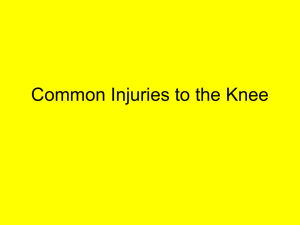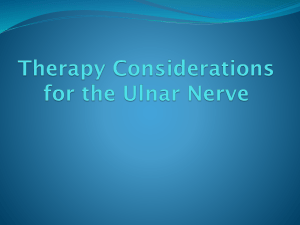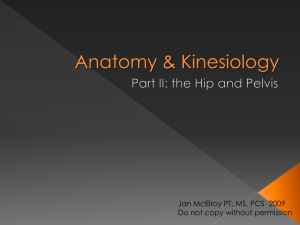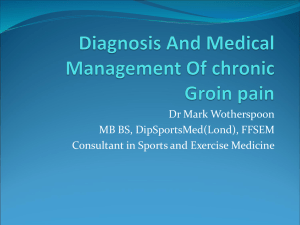Tendon - Science And Football
advertisement
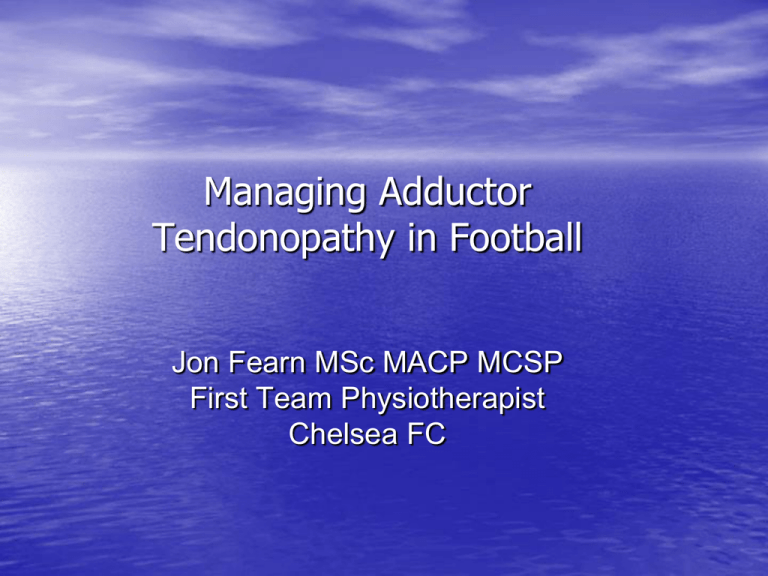
Managing Adductor Tendonopathy in Football Jon Fearn MSc MACP MCSP First Team Physiotherapist Chelsea FC Possible causes of groin pain in athletes reported in the literature Abdominal aortic aneurysm Acetabular disorders Adductor strain Hydrocoele/varicocoele Inflammatory bowel disease Inguinal or femoral hernia Postpartum symphysis separation Prostatitis Pubic instability Adductor tendinopathy Apophysitis Appendicitis AVN of femoral head Avulsion fracture Bursitis Conjoined tendon dehiscence Intra-abdominal abscess Legg-Calve´-Perthes disease Lumbar spine pathology Lymphadenopathy Muscle strain Myositis ossificans Nerve entrapment Sacroiliac joint problems Seronegative spondyloarthropathy Slipped capital femoral epiphysis Snapping hip syndrome Sports hernia Stress fractures Synovitis Crohn’s disease Obturator nerve entrapment Tendon (Adductor): Partial Adductor Shear Osteitis pubis Osteoarthritis PS / Hip Ovarian cyst Pelvic inflammatory disease Pelvic stress fracture Tendon (Adductor): Rupture tear / injury Diverticular disease Epididymitis FAI Herniated nucleus pulposus Hockey player’s syndrome Testicular neoplasm Testicular torsion Urethritis Urinary tract infection 69% of groin injuries in football have Adductor complex issues (Holmich 2007) Long Standing Adductor Related Groin Pain (LSARGP) • ‘Groin pain’ is 4th most common injury affecting • • • soccer players (10%) (Walden 2007, Hawkins 2001) Causes 3rd longest absence from sport behind fracture & ACL injury Acute Groin injury: 86% heal within 3 weeks But 13.5% Don’t!! Previous groin injury: 9% chance of recurrence (No Hx GP =2%) (Arnason et al 2004) • Tendon pain is common in athletes • Adductor tendon issues common issue in LSARGP Adductor Longus Enthesis • Anterior AL: Tendinous • Posterior AL: Muscular • Area of concentrated stress at • • Bone-tendon junction (Tuite et al 1998, Strauss 2007) Pathology involves: AL (70%), Magnus (15%), other (15%) (Lovell 2001) Enthesopathy rather than tendinopathy! Tendon (Site v Function) • • • Achilles • Long mid-tendon Excellent shock absorber • Dissipates energy quickly • and efficiently Adductor Tendon is short Exposed to tensile and Shear forces Has to dissipate forces quickly+ Main Clinical Findings in LSARGP • Pain – strong association between location of pain felt and site of pathology (Lovell 1995) • Weakness (? pain inhibition or actual) • Reduced Performance e.g. kicking, cutting, agility Predisposing factors for Tendon injury • Optimal load is essential for healthy tendon • • • • • • (‘Mechanotransduction’ : Khan & Scott 2009) ‘Too little’ / Sudden Underload e.g. injury, holiday ‘Too much’ / Sudden Overload e.g. excessive increase in training Compression e.g. trauma Poor Conditioning of MT unit Poor biomechanics Mechanically active gene presence: Predispose or Protect? (Mokone et al 2002 or September et al 2008) Common Clinical findings Tendonopathy • • • • • • • Pain associated with activity / load Specific location of pain (30% Bilateral ) AM pain/stiffness (VAS score) Eases with activity (VISA questionnaire) Local tenderness (not pathological specific!) Functional impairments (Test battery: CMJ, Hop, Drop CMJ, Toe-raise strength tests - Silbernagel et al 2006) Imaging: Decide degree of pathology initially with a Good History Pain v Pathology Imaging = Pathology (Khan 1996, Yu 1995,etc) Pain ≠ Pathology Load ‘Iceberg Theory’ ...but dictates our success!! (Ohberg et al 2001; Fredberg & Stengaard-Pedersen 2007) PAIN DETECTION THRESHOLD • Abnormalities on imaging are present before they become symptomatic (Lovell et al 2006; Malliaras 2006, Fredberg et al 2008) Time • Explains relapse of symptoms if resume activity too soon! • Tendon mechanics remains unaltered in tendonopathy (Hansen et al 2006; Kongsgaard et al 2009) ‘Load-induced’ Tendon Pathology Continuum NORMAL TENDON FASCIITIS? (Franklyn-Miller et al 2009) PROLIFERATIVE / REACTIVE TENDONOPATHY ? TENDON DYSREPAIR (failed healing) DEGENERATIVE TENDONOPATHY …..RUPTURE? (Cook 2009) NB: Mixed pathology is often present ! (Khan et al 1999, Llan et al 2007) Aim of Tendonopathy Management In theory: To attempt to remodel the tendon matrix In practise: To attempt to remove pain Restore muscle tendon function How do we manage these patients? • • • • • Rest Injection therapy / Dry needling Medication Electrotherapy Compression shorts • Surgery • Manual therapy • Exercise Therapy The Surgical option…? ‘Surgery takes longer to return to sport than conservative management!’ • Adductor tendon ruptures; NFL players • Surgery (n=5); Conservative (n=14) • Surgery RTS: 12 weeks (10-16) • Conservative RTS: 6 weeks (3-12) (Schlegel 2010) Manual Techniques • • • • SSTM Physiological Accessory Dynamic Combined (Hunter 1990) Van Den Aaker method Multi modality treatment (MMT) (Heat/STM/Stretching/Running program; 90% RTS: Weir 2008) NB: Thomas’ test: ITB/TFL stiffness Manual Therapy v Exercise therapy n=ET:25/MT:29;+ive local Adductor pain signs (Holmich 2004) • ET group (n=25); Allowed to run at 6 weeks! • MT group (n=29); Allowed to run at 14 days or earlier! Return to running program (Phase 1-3: slow jog, straight line, cutting) • MT: 50%Return to Sport • • • • • at 12.8 weeks ET: 55% RTS at 17.5 weeks Home exs programme! Unsupervised! No control Recurrences after 4 month F/U? (Weir et al 2011) Isometric Adductor strength in Footballers • Adduction > Abduction irrespective of • • dominance Dominant > non-dominant (3% Adduction / 4% Abduction) Hip Add/Abd ratio is 1.05 in footballer (Thorborg et al 2010) Nicholas & Tyler 2002 suggest Add:Abd ratio: >90%; Adductor strength L=R before for RTS Adductor Weakness in LSARGP • Add : Abductor Ratio was 24% lower in groin • • pain athletes (Thorborg et al 2010) Squeeze test was significantly weaker (20%) in players with longstanding groin pain (Malliaras et al 2009) Player was 17 TIMES more likely to get adductor muscle strain if Adductor strength was <80% of Abductor strength (Tyler et al 2001, O’Connor 2004) ‘Exercise Therapy’ in LSARGP • varies! Verrall et al 2007: 63% return to sport but only • • • 41% to pre-injury level (rest, swim, bike, stepping, core exs) in Pro Aussie Rules 10 weeks RTS with ET (Wollin & Lovell 2006) Rodriguez et al 2001: combined local passive Rx (ET, ice) and progressive strength program over 10 weeks – 100% success Ekstrand & Ringborg 2001: strengthening exs had short term benefit but poor adherence long term BUT ALL STUDIES SHOW BENEFITS! Exercise therapy v ‘Physiotherapy’ Active Training (n=30) e.g. Abd/adduction strength exs, sit ups, balance training, slide board Physiotherapy Treatment (n=29) Laser, Frictions, Stretching, TNS NB: Hx of Groin pain (≈ 40 weeks) Amateur athletes At 4 months: • 79% of AT group had no residual groin pain and RTS NB: ONLY 14% of PT group! • Return to sport took between 13-26 weeks (median 18.5 weeks) (Holmich et al 1999) Take care with excess load on tendon! • After single bout of prolonged exercise (3 hour run) leads to increase in type 1 collagen synthesis in the peritendon (Langberg et al 1999) • Seen in Proliferative/Reactive tendinopathy • Care reintroducing into exercise within 72 hours! • Tendon loading magnitude (e.g. HSR) positively relates to anabolic gene expressive (Lavagnino 2003, Arnoczky 2007) Undulating Tendon Loading Programme • No / minimal pain during • • • exercise (VAS 3/10 max) 3 sec per Rep / 2 min rest Varying loads and reps Aim to mimic athletic movement in different ways (e.g. Isometrics, strengthening, running, jumping, kicking, etc) • Progress Range, Load, Speed • High load every 3-4 days! • Type 1 production requires 23 days to peak (Fredberg 2004) Session Exercise Sets Reps Intensity (%) 1 A 3 6 80 B 3 6 85 C 3 6 85 A 3 15 40 B 3 15 40 C 3 15 40 A 3 10 60 B 3 10 70 C 3 10 70 2 3 Periodising Tendon Load in Late stage rehabilitation Why do Eccentrics on Tendonopathy? ‘Is it too aggressive for some tendons?’ ‘Are there better methods? Not for every tendon problem! Is it ‘Strength’ that’s essential? Does high load eccentric training just strengthen the MT unit? Why not just get the unit stronger through conventional means (concentric and eccentric)? • Effective in Achilles tendon (Silbernagel et al 2001) • Effective in Patellar tendon (Kongsgaard et al 2009) Don’t avoid concentric! Control movement velocity! (‘Time under tension’) Classic Strength Training ‘Are players working hard enough?’ Motor control Work capacity ‘TO FATIGUE’ Maximal Strength Power Volume Isometric 3-5 x 20+ Reps 3-5 x 30-60sec 3-5 x 5-12 Reps 3-5 x (4-6 x 30-20 sec) 3-5 x 6-2 Reps 3-5 x(10 x 6sec) 3-6 x 2-3 Reps 3-6 x 5-10 Plyos Frequency 3-7 x / week 2-3 x / week 1-3 x / week 1-3 x / week Muscle Adaptation Slow twitch hypertrophy Whole muscle hypertrophy Fast twitch hypertrophy Fast twitch hypertrophy Tendon Adaptation None Tendon hypertrophy – 5% at each end i.e. ‘areas of most stress’ Tendon hypertrophy Increased passive stiffness If high volume: tendon hypertrophy Increased passive stiffness (Brandon 2010, Foure et al 2009, Arruda et al 2006) Remember Tendon is slow to adapt! Tissue Responses Neural 1-3 weeks Muscle > 3 weeks Tendon > 6 weeks Key Tendon Rehab points! • Where does pathology sit on the continuum? • High load every other or third day • Deliver load in different ways (via strength exs, • • • • • plyometrics, functional load e.g. kicking) Combine HSR with eccentric training once able! But monitor response & periodise load acordingly Monitor subjective markers (AM pain/stiffness, VAS on activity, VISA) Monitor objective markers Tendon Rehab takes time despite anatomical site (i.e. 3 months!) Tendonopathy Exercise Therapy Early phase: • Off-load for 7-10 days??? • Isometric loading (12-5 reps x 5-30 sec) Intermediate/Late phase: • Heavy Slow Resistance training (3 x/week) • (3 sec conc/ecc – 4 x 8-15 each exs) (Patellar tendon : Kongsgaard et al 2009) Eccentric loading daily (Low/Med/High load every 3 days) ‘Local’ Adductor tendon loading • Ensure strength & stability function restored • 3 staged Strength Protocol • Level 1 targets: Squeeze test P1/Max Effort 50%/150mmHg; Painfree FROM on 7 stretch program; Complete all level 1 exercises painfree • Level 2 Targets: Pubic stress test (max resistance); Squeeze 200+ mmHg / 75% Normal; Completed all above exercises painfree • Level 3 aims: Single SL Side bridge painfree; Full high load function Target all ‘functional’ Global systems 1. Posterior oblique 2. Anterior oblique* Lat Dorsi BicepsFemoris Gluteus Maximus ST lig TDF EO and contralat IO Contalat Adductors Anterior Abdominal Fascia and TA 3. Deep longitudinal 4. Lateral sling* ES MTF Biceps Femoris (long head) Deep lamina TDF, ST, Int & SD ligs Gluteus Medius and minimus Contralateral Adductors TFL (Vleeming 1995) Monitor Progress 1. 2. 3. 4. 5. Pain during exercise Pain +/- ‘stiffness’ next morning Squeeze test (0°,60°,90°) Isometric strength test Pubic symphysis stress test (Ext/Abd, Resist flex/add) 6. Adductor muscle tone (BKFO, ABD ROM, Palpation) (Hogan 2003) SIJ Stabilisation belts • Groin pain patients have less adductor strength than healthy subjects (N = 44, mean duration of symptoms:16.3 months) • Adding Pelvic belt = Average 10% increase in strength (39% increased by 20%) and reduced pain Mens et al 2006 ‘High load’ functional activities • • • • SL loading+ Med ball drills Tackling + Kicking Agility + Cutting drills Comprehensive treatment plan • All with proximal insertional adductor pain on palpation and pain on squeeze • • • • • • • • • Adductor strength program (Holmich 1999) TA activation (Cowan et al 2004) Mobilise Hips (Williams 1978, Ibrahim et al 2007, Verrall et al 2007) Mobilise SIJ (Marshall & Murphy 2006) 4 phases of recovery; Each stage had goals to achieve 77% Return to pre-injury level without symptoms In average 20 weeks (70-221 days) 70% competing at 22 months (within 6.5-51 months) But 26% re-occurred…therefore ensure MAINTENENCE WORK continues! (Weir et al 2010) Return to Training Criteria • Injury based tests e.g. Squeeze test, Isometric Abd = Add / R=L, Cross hands squeeze, DL abs lowers x 24, Scissor beats x 1 min, SL bridge, level 3 strength R=L • Rehabilitation criteria e.g. Kicking*, Cut/Agility at High intensity, Sprint, Cross-over hop, etc • Physiological criteria V02max / Yo-yo, GPS data (Max speed, max accel, loading R=L?) Rehabilitation into Training! High intensity lateral movement ESSENTIAL! Especially… Agility / Accelerations (GPS data) Evidence based Adductor rehabilitation • dysfunction Local Adductor strengthening (Isometric test) • • • • • • • • • Normalise Adductor tone / ROM (BKFO) Local trunk dissociation control (Pilates) Global functional strength (Squeeze test) Progressive Functional rehabilitation (3 stage adductor protocol) Utilise SIJ belt (enhance force closure) Bilateral Hip & SIJ mobility (measure, Gillets) Thoracolumbar junction mobility & Neural tests Fascial techniques & dSSTM to adductor complex Pain management / medical intervention



